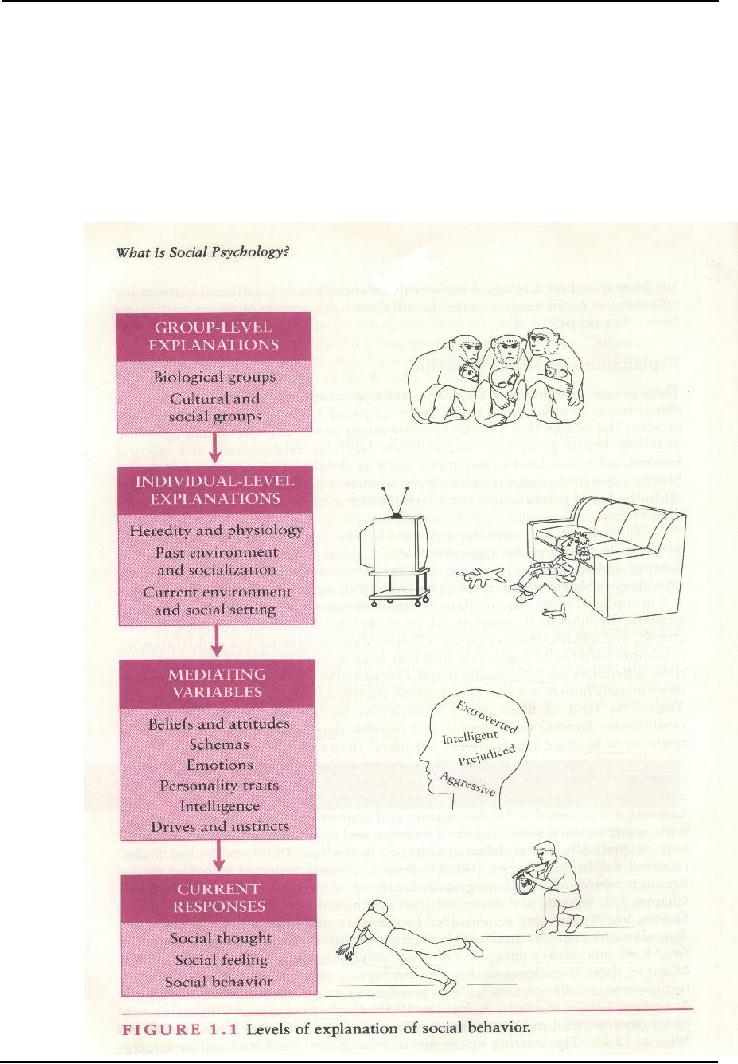 |
INTRODUCTION TO SOCIAL PSYCHOLOGY:Readings, Main Elements of Definitions |
| INTRODUCTION TO SOCIAL PSYCHOLOGY:Social Psychology and Sociology >> |

Social
Psychology (PSY403)
VU
Lesson
01
INTRODUCTION
TO SOCIAL PSYCHOLOGY
Aims
Introduction
of social psychology is a very
important discipline of
psychology.
Objectives
1.
Defining social psychology.
2.
Introduce main content and subject matter
of social psychology in relations to
different questions of
interest
in this discipline.
General
Introduction of the
Course
Social
psychology is the scientific study of
how people think, influence,
and relate to one another. It is a
comparatively
young discipline. The broad
theme of this course will be
how individuals' thoughts,
feelings,
and
behaviors are influenced by
other people -- the SOCIAL
influences. Social Psychology is a
surprisingly
broad
field that overlaps with
other sub-disciplines of psychology
like personality and cognition, and
various
other
human disciplines like anthropology,
sociology, and communication.
Learning
Objectives of this course
To
acquaint
the students with the field of social
psychology. When we say "the
field of psychology, we
mean
a broad range of topics relevant to social
psychology, general scientific approach of the
discipline, and
various
concepts, principles, and theories
pertaining to this
discipline.
To
provide many insights into
our own and others'
behavior.
Benefiting
one's own relationships and
services as a friend,
relative,
roommate,
neighbour, and co-worker
Practical
application of this
course
Through
journal writing and Applied social
psychology Lab students will
be able to experience the personal
relevance
of social psychology. The introduction of
these two procedures is as
under:
Journal:
One
means of enhancing the course's personal relevance is
an assignment called a
"Journal",
which
students will accomplish as the course
will proceed.
Applied
Social Psychology Lab:
Different classroom activities
will be conducted to give students
a
practical
overview and knowledge about the
application of Social Psychology by
case reports, small
activities,
and current research
By
the End of this course
students will be able
to:
Demonstrate
foundational knowledge in social
psychology
Apply
social psychological phenomena to
one's own thinking,
behavior, and relationships
Recognize
the extent to which social behaviors
are influenced by situational and
interpretive
factors
Readings
Text
Books
Franzoi,
S.L. (2006). Social
Psychology. New York: McGraw
Hill.
David
G. Myers, D. G. (2003). Social
Psychology (7th ed.). New
York: McGraw-Hill.
Other
Readings
Lord,
C.G. (1997). Social
Psychology. Orlando: Harcourt
Brace and Company.
Lippa,
R.A. (1994). Introduction to
Social Psychology... Belmont:
Brooks/Cole Publishing
Company.
1

Social
Psychology (PSY403)
VU
What
is Social Psychology?
In
the following two definitions of
social psychology have been described,
the first of these has been
quoted
in
majority of the textbooks on social
psychology.
Social
psychology is a discipline that
uses scientific methods in
"an attempt to understand and explain
how
the thought, feeling and
behaviour of individuals are
influenced by the actual, imagined or
implied
presence
of others" (Gordon Allport,
1985, p. 3).
Social
psychology is the scientific study of
how individuals think. Feel,
and behave toward other
people
and
how individual's thoughts,
feelings, & behaviours are
affected by other people
(Brehm, Kassin, & Fein,
2002,
p. 5).
Main
Elements of Definitions
Thoughts,
Feelings, and Behaviours of
individual
Influence
of other people
How
these influences will be studied? It
will be done
by
the use of Scientific
Method.
The
definitions suggest a cause and
effect equation people
influencing individual's thoughts,
feelings and
behaviour.
Main
Questions of Interest in Social
Psychology
The
topics of social psychology--attitudes, person
perception, interpersonal attraction,
conformity, etc. are
among
the most personal but largely
unexamined parts of ourselves. Questions
of interest in social
psychology
can be divided into 3 categories:
these 3 categories correspond to
thoughts, feelings and
behaviour
components of definition of social
psy. However, this is merely
a convenient way of
organization,
one
overlaps with other
part.
The
main questions/ topics of interest in social
psychology are as given
below:
Thinking
about the self and others
Evaluating
persons and relationships
Interacting
with others
Ist
Question: Thinking about the self &
others
Each
question of interest can be further
divided into different categories.
For example, different
questions
can
be asked under this first
question of interest. The following 4
questions seem diverse but
they refer to
the
thought process.
Social
cognition is thought process in
general; however, other questions
given below investigate one
specific
kind
of thinking.
Social
cognition:
Researchers who are working
on social cognition can ask the
following question in their
investigation:
"How do jury decide guilt or
innocence"
Person
perception: People
working on person perception
can be curious to know: "How do we
know
when
someone is lying or telling
truth"
Attribution:
It
refers to thought process that occur
when we decide what caused another
person's behavior
The
self: We ask
specific questions about ourselves, for
example one may be inquisitive
that "when does a
thin
body image promotes eating
disorders"
2nd
Question: Evaluating people &
relationships
The
following 5 questions also seem
diverse but they all
involve people's feelings.
Attitude is the most
basic
type
of field - about feeling in
general.
Attitude:
feelings
lie at the core of + and neg. attitudes;
how feelings, thoughts and
behaviour relate to
each
other: why people feel
one way and yet behave in
exactly the opposite
way
Attitude
change: This
question of social psychology is
concerned with when and
why people alter
their
attitude
over time. For example,
"how can we instill positive
attitude in children toward
school".
2

Social
Psychology (PSY403)
VU
Prejudice:
People
interested in research on prejudice, etc.
may also be interested in investigating
that "how
can
society reduce stereotyping and
discrimination"
Interpersonal
attractions: These
issues may question, "why do
people desire to make
friends with one
and
not the others", or "why
people feel romantic
attraction for one and not
for other person".
Close
relationships: Researchers
working in this area may be
inquisitive that "how our
feelings toward
significant
others change over time",
for example, how happy
marriages end into bitter
divorces.
3rd
Question: Interacting with
Others
Human
beings interact through many
different behaviours, some of them
are given below:
Social
Influence: studies
how one person's behaviour/ presence
influences another person's behaviour.
Helping:
"How
can we convince more people to
help disabled"
Aggression:
"Does
media violence promotes violence in real
life" why people assault,
hit, and kill each
other
Interpersonal
Power: why
ordinary citizens sometime engage in
torture, ethnic cleansing, or genocide
Groups:
"Why
can't one religious group
agree with the other"...
whether people behave differently
while
in
group.
The
above mentioned 14 questions, which correspond to
three main questions of interest as indicated in
the
definition
of psychology, have been the content of
majority of the text books on
social psychology in the
form
of different chapters of the text.
This suggests that the subject matter of
social psychology is different
components
of thoughts, feelings, and behaviours of
individuals.
How
Others' Presence Affect an
individual?
The
definition of social psychology suggests
that it is the scientific study of
how individual's
thoughts,
feelings,
and behaviours are
influenced by the actual, imagined or
implied presence of other
people. To
better
understand this definition, let's
take a few examples.
Actual
Presence of people affecting the
individual:
First
take an example, how might
the actual presence of others influence
one's thoughts, feelings and
behaviour.
Response of cricket players
may become different when
fans of some opposing team
shout and
make
loud noises to divert
attention of the players. Similarly,
your behaviour will be
changed if you notice
that
someone is watching
you.
Imagined
Presence of people affecting the
individual:
Regarding
how the imagined presence of
others might influence
thoughts, feelings, and behaviour,
think
about
past incidents when you were
considering doing something that ran
counter to your parents'
wishes.
Although
they may not have been
actually present, did their
imagined presence influence
your behaviour?
For
example, if your parents have
prohibited you from smoking,
and you start smoking in a
party on peer
pressure,
does their imagined presence
affect your behaviour?
Imagined presence in certain
cases can be
quite
strong, as indicated by Shaw (2003),
"Imagined figures can guide
our actions by shaping our
interpretation
of events just as surely as do
those who are physically
present". In a few conditions,
imagined
presence
can also help us fight
negative emotions. For example,
McGowan (2002) pointed out
that in
anxiety
imagined presence of others
can serve as emotional
security blanket. Similarly,
daughter of one
renowned
social psychologist confided to her
father that she wants to be
as brave as two young
wizards,
Harmione
& Harry in Harry Potter books.
Implied
Presence of people affecting the
individual:
Finally,
how the implied presence of
others influence an individual? If
you have an experience of driving
on
the
motorway, you would have
noticed that signs of
specific speed limit make
you conscious. Similarly,
in
3

Social
Psychology (PSY403)
VU
shopping
stores sometime posters
indicate that "You are being
watched"... All of this makes
you self ware
and
brings a change in your
behaviour.
Other
Factors affecting the
individual
Social
psychologists also believe that it is
not only the presence of
other people that influences
a person's
thoughts,
feelings and behaviour, but
some other factors are also
contributing to that. In this reference,
three
kinds
of explanations of social behaviour can
be presented. Figure1.1 presents the
factors that a social
scientist
might use to explain human
behaviour.
This
diagram shows that three
explanations can affect human
social behaviour in following
ways:
4

Social
Psychology (PSY403)
VU
Broad
group
level explanations, i.e.,
evolutionary and cultural
factors
Individual-level
explanations:
such as childhood experiences, and family
history
Mediating
variables:
internal factors such as personality
traits, and attitudes.
1.
Broad Group-level Explanations:
Evolutionary and Cultural
Factors
Animals
show different pattern of aggression
than human beings, These are
biological based. e.g.,
organized
warfare
seems to be a uniquely human activity.
Similarly, people living in
different countries demonstrate
differences
in exhibition of aggression. Evolutionary
factors indicate that people
living at particular
places/
locations
have evolved with a tendency to become
more or less aggressive to outsiders than to
their own
kind?
For example, tension and
resulting aggression in Yugoslavia and
other countries like Israel
and
Palestine
could be due to evolutionary and
cultural factors both. To explain
cultural differences in
aggressive
behaviour,
Margaret Mead (1935)
reported that some societies
are peaceful (e.g., Arapesh
of New Guinea)
while
others, although living in the same
geographical region) are
dominating and aggressive (e.g.,
Mundugumor
of New Guinea)
Differences
have also been reported in
world-wide Violence rates,
for example, in 1980s, violence
rates of
8.5%/100,
1000 were reported in the USA as
compared to 1.9% in Canada, and
0.6% in the UK. These
different
statistics indicate effects of culture
and evolutionary factors on social
behaviour.
2.
Individual-level Explanations
Heredity
&
physiology: Genetic and biological
factors also influence human social
behaviour. For
example,
males have been found more
aggressive than women due to a male
hormone testosterone (Eagly &
Steffan,
1986). Moreover, men with
higher levels of testosterone have
been reported as more aggressive
than
those
with lower levels (Dabbs &
Morris, 1990).
Past
experiences: Early learning and
child rearing practices also
contribute to differences in people's
social
behaviour.
For example, girls are
taught not to be aggressive by
their parents from their
childhood.
Moreover,
expression of anger is not appreciated in girls
and women. This gender
difference is also
very
pronounced
in some cultures, so culture also
plays a dominant role in
these associations. This
also suggests
that
these group or individual
level explanations are not
mutually exclusive; they all
seem to interact with
each
other. Another example can
be how aggression would have
been created and shaped in
Kashmiris and
Palestinians
by the teachings of their parents in the
process of growing
up.
Current
situational factors could also
influence a person's behaviour. The
classic study of Hovel and
Sears
(1940)
could be illustrative in this
case. They found a
significant correlation between economic
frustration
and
lynching of black by white
people in Old South. Media
violence is an ever-present influence as
far as
situational
factors are concerned. Another
example is conformity research, where
results showed that
how
group
pressure can induce people
shift their beliefs
3.
Mediating Variables
Mediating
variables create a link between
situational, cultural, and
individual level explanations.
These are
related
with the person concerned and
can not be directly observed, so
they must be inferred from a
person's
behavior.
The effect of mediating
variables indicate that for
understanding a person's thoughts,
feelings and
behaviour,
one must slip inside the
skin of the individual. The
following refer to different
mediating
variables:
Beliefs:
compromise
the cognitive information.
Attitudes
are
evaluative responses.
Schemas:
a kind of mental model that
people hold
Emotions:
transient
states of arousal that direct
our behavior
Personality
traits are stable
dispositions influencing broad domains of
behavior
5

Social
Psychology (PSY403)
VU
Current
Responses of the
individual
Figure
1.1 indicates that all of
these evolutionary, cultural,
individual, situational, and mediating
variables
determine
a person's social thoughts, feelings and
behaviour.
Readings
1.
Franzoi,
S.L. (2006). Social
Psychology. New York: McGraw
Hill. Chapter 1.
2.
Lord,
C.G. (1997). Social
Psychology. Orlando: Harcourt
Brace and Company. Chapter 1.
3.
Lippa,
R.A. (1994). Introduction to
Social Psychology... Belmont:
Brooks/Cole Publishing
Company.
Chapter 1.
6
Table of Contents:
- INTRODUCTION TO SOCIAL PSYCHOLOGY:Readings, Main Elements of Definitions
- INTRODUCTION TO SOCIAL PSYCHOLOGY:Social Psychology and Sociology
- CONDUCTING RESEARCH IN SOCIAL PSYCHOLOGY:Scientific Method
- CONDUCTING RESEARCH IN SOCIAL PSYCHOLOGY:Evaluate Ethics
- CONDUCTING RESEARCH IN SOCIAL PSYCHOLOGY RESEARCH PROCESS, DESIGNS AND METHODS (CONTINUED)
- CONDUCTING RESEARCH IN SOCIAL PSYCHOLOGY OBSERVATIONAL METHOD
- CONDUCTING RESEARCH IN SOCIAL PSYCHOLOGY CORRELATIONAL METHOD:
- CONDUCTING RESEARCH IN SOCIAL PSYCHOLOGY EXPERIMENTAL METHOD
- THE SELF:Meta Analysis, THE INTERNET, BRAIN-IMAGING TECHNIQUES
- THE SELF (CONTINUED):Development of Self awareness, SELF REGULATION
- THE SELF (CONTINUE…….):Journal Activity, POSSIBLE HISTORICAL EFFECTS
- THE SELF (CONTINUE……….):SELF-SCHEMAS, SELF-COMPLEXITY
- PERSON PERCEPTION:Impression Formation, Facial Expressions
- PERSON PERCEPTION (CONTINUE…..):GENDER SOCIALIZATION, Integrating Impressions
- PERSON PERCEPTION: WHEN PERSON PERCEPTION IS MOST CHALLENGING
- ATTRIBUTION:The locus of causality, Stability & Controllability
- ATTRIBUTION ERRORS:Biases in Attribution, Cultural differences
- SOCIAL COGNITION:We are categorizing creatures, Developing Schemas
- SOCIAL COGNITION (CONTINUE…….):Counterfactual Thinking, Confirmation bias
- ATTITUDES:Affective component, Behavioral component, Cognitive component
- ATTITUDE FORMATION:Classical conditioning, Subliminal conditioning
- ATTITUDE AND BEHAVIOR:Theory of planned behavior, Attitude strength
- ATTITUDE CHANGE:Factors affecting dissonance, Likeability
- ATTITUDE CHANGE (CONTINUE……….):Attitudinal Inoculation, Audience Variables
- PREJUDICE AND DISCRIMINATION:Activity on Cognitive Dissonance, Categorization
- PREJUDICE AND DISCRIMINATION (CONTINUE……….):Religion, Stereotype threat
- REDUCING PREJUDICE AND DISCRIMINATION:The contact hypothesis
- INTERPERSONAL ATTRACTION:Reasons for affiliation, Theory of Social exchange
- INTERPERSONAL ATTRACTION (CONTINUE……..):Physical attractiveness
- INTIMATE RELATIONSHIPS:Applied Social Psychology Lab
- SOCIAL INFLUENCE:Attachment styles & Friendship, SOCIAL INTERACTIONS
- SOCIAL INFLUENCE (CONTINE………):Normative influence, Informational influence
- SOCIAL INFLUENCE (CONTINUE……):Crimes of Obedience, Predictions
- AGGRESSION:Identifying Aggression, Instrumental aggression
- AGGRESSION (CONTINUE……):The Cognitive-Neo-associationist Model
- REDUCING AGGRESSION:Punishment, Incompatible response strategy
- PROSOCIAL BEHAVIOR:Types of Helping, Reciprocal helping, Norm of responsibility
- PROSOCIAL BEHAVIOR (CONTINUE………):Bystander Intervention, Diffusion of responsibility
- GROUP BEHAVIOR:Applied Social Psychology Lab, Basic Features of Groups
- GROUP BEHAVIOR (CONTINUE…………):Social Loafing, Deindividuation
- up Decision GROUP BEHAVIOR (CONTINUE……….):GroProcess, Group Polarization
- INTERPERSONAL POWER: LEADERSHIP, The Situational Perspective, Information power
- SOCIAL PSYCHOLOGY APPLIED: SOCIAL PSYCHOLOGY IN COURT
- SOCIAL PSYCHOLOGY APPLIED: SOCIAL PSYCHOLOGY IN CLINIC
- FINAL REVIEW:Social Psychology and related fields, History, Social cognition